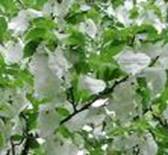| Kingdom | Plantae |
| Division | Magnoliophyta |
| Class | Magnoliophyta |
| Order | Cornales |
| Family | Cornaceae |
| Genus | Davidia |
| Species | D. involucrata |
| Binomial name | Davidia involucrata |
Other Common Names:
The other common names for the dove tree are Handkerchief Tree and Ghost tree.
History
This elegant and rather exotic looking tree is still rare in cultivation in Europe. It was believed to have been extinct after the glacial era; however, in late 19th century some specimens were found in Sichuan, China. Dove tree was brought to Britain in 1903 and cultivated as a rarity in some gardens of the tempered climate. Its main attraction is the large, white bracts surrounded around a small, green flower head in May. Owing to the bracts shape this plant is also called handkerchief tree.

Description
The dove tree is a deciduous member of the Nyssa family and attains a height of 35 feet, with a more or less pyramidal form. Leaves are heart-shaped and coarse textured. The bright to dark green leaves are roughly heart-shaped (cordate) and lightly serrated around the edges. The leaves of the species are white tomentose underneath, which appears as a fine white felt on the undersides of the leaves.



Range
The tree is native to central China, from Hubei to southern Gansu, south to Guizhou, Sichuan and Yunnan.
Habitat
Grow in full sun or part shade in fertile and it needs a moist but well-drained soil. The dove tree generally avoids areas with strong winds.
Cultivation
It needs well-drained but constantly moist soil, rich in humus and preferably deep. Do not grow it in windy areas. It is fully hardy to -24°C (USDA zone 6) and can withstand temporary swings to -27°C in protected locations.Davidia appreciates a little shelter in its formative years, but will eventually reach a size where few other trees are large enough to shade it. This tree should be grown where it has room to spread and reach its fullest potential. Although tolerant of some pruning, Davidia can not be successfully maintained at a reduced size. Sow entire fruit in a container or bed outdoors, or take softwood cuttings in autumn and hardwood cuttings in winter. Germination usually takes two years.
Seedlings can grow rapidly, producing a flowering specimen in as little as ten years. For a tree, that's pretty remarkable. Recent tests suggest that the entire fruit should be planted for best results. Although there may be several embryos inside the nutlet, only one will germinate. These must not be removed from their protective shell. If you do clean away the leathery fruit that covers the nutlet, do not let the nutlet dry out, as this will inhibit germination. Germination can take up to eighteen months, but seedlings and saplings grow rapidly, almost as though to make up for lost time. Germination can be slow, during which time the seed should be exposed to the natural seasonal temperatures - though protect from dips much below -5°C (25°F)
Flowering Season
The small pom-pom like blooms appear in mid-spring and are held between two uneven, pure white bracts that are up to 15cm long.
Pests and Diseases
Canker, coral spot, leaf blight and scale insects. Leaf blotch can be a significant problem. Powdery mildew and anthracnose are also frequent problems. Leaf scorch (brown edges) may occur in droughty conditions or on sites exposed to wind.
Parts Used

The leaves are the commonly used parts of the tree for its limited medicinal and commercial value.
Medicinal Applications

• It is used by indigenous people to externally treat wounds, haemorrhoids and fractures.
• It is used in treating in treating stomach ulcers, ulcerative colitis, dysentery and diarrhea.
• It is mainly used in treating skin infections, fungi, rashes, and dermatitis.
• As a topical cream it was used for boils and sores.
Commercial Applications

• China where it reaches 20 metres in height. It deserves to be more frequently used here in landscape design, but trees under 20 years of age flower r sparsely.
• The dove tree makes excellent firewood.
• The bark has been used as a roofing material.
• The leaves are either eaten raw or cooked.

The Dove tree (Davidia involucrata), whose flower became a symbol of the Przelewice Dendrological Garden and is embodied in the coat of arms of Przelewice Borough, is listed in the World Red Book of endangered and extinct plants worldwide. The folklores says that the tree got its name when on a windy day the white bracts of the flowers started fluttering like the white doves flying in the sky.